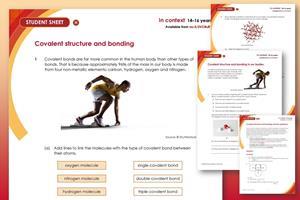The human body provides a great context for learners to apply their understanding of covalent bonding
Covalent bonds are far more common in the human body than other types of bonds. That is because approximately 96% of the mass in our body is made from four non-metallic elements: carbon, hydrogen, oxygen and nitrogen.
-

Download this
A foundation and higher level worksheet to put learning about covalent bonds into context with questions related to the human body. Answers are included in the teacher notes.
View and download more In context worksheets
About this resource
These In context worksheets ask learners to use their knowledge of covalent structure and bonding in the context of the human body, building their confidence and capability to face exam questions. With a mixture of multiple-choice, short answer and long-answer questions covering the following topics:
- properties of covalent compounds
- dot and cross diagrams
- limitations of models used to represent covalent compounds
- relative formula mass.
Calculation questions are included to give opportunities to practise mathematical skills within this topic. The worksheets are available at foundation and higher level and as fully-editable versions, giving you the flexibility to select the questions most relevant to a particular lesson.
Downloads
Covalent structure and bonding in context student (higher)
Handout | PDF, Size 0.4 mbCovalent structure and bonding in context student (foundation)
Handout | PDF, Size 0.36 mbCovalent structure and bonding in context teacher notes
Handout | PDF, Size 0.37 mbCovalent structure and bonding in context student (higher)
Editable handout | Word, Size 0.3 mbCovalent structure and bonding in context student (foundation)
Editable handout | Word, Size 0.32 mbCovalent structure and bonding in context teacher notes
Handout | Word, Size 0.28 mb
Additional information

































No comments yet